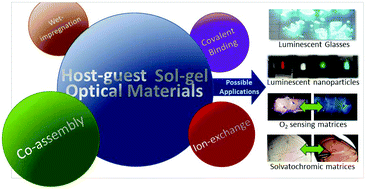Host–guest luminescent materials based on highly emissive species loaded into versatile sol–gel hosts
Abstract
Sol–gel chemistry has been extensively employed to produce several classes of materials (e.g. nanoparticles, thin films, fibers, gels, glasses and ceramic powders) with desired easily-controllable morphological, crystallographic and mechanical properties. In particular, the methodology can be explored for the development of optical supramolecular materials with interesting properties for light-emitting devices, chemical and biological sensing, biomarking and targeting, among many others. To this end, the strategies usually adopted consist of embedding a luminescent guest species into normally non-emissive sol–gel host materials, resulting in optical systems that preserve both the guest's photophysical characteristics and the host's mechanical and morphological properties. This concise review provides insights into the development of promising new host–guest optical materials based on versatile sol–gel hosts (i.e. mesoporous MCM-41 nanoparticles, mesoporous sodium-aluminosilicate glasses and other mesoporous matrices for sensors) and highly luminescent guests (i.e. organic dyes, d6 complexes and lanthanide complexes), mostly focusing on the findings from our group and similar findings in the literature of the past decade.

- This article is part of the themed collection: 2018 Frontier and Perspective articles


 Please wait while we load your content...
Please wait while we load your content...